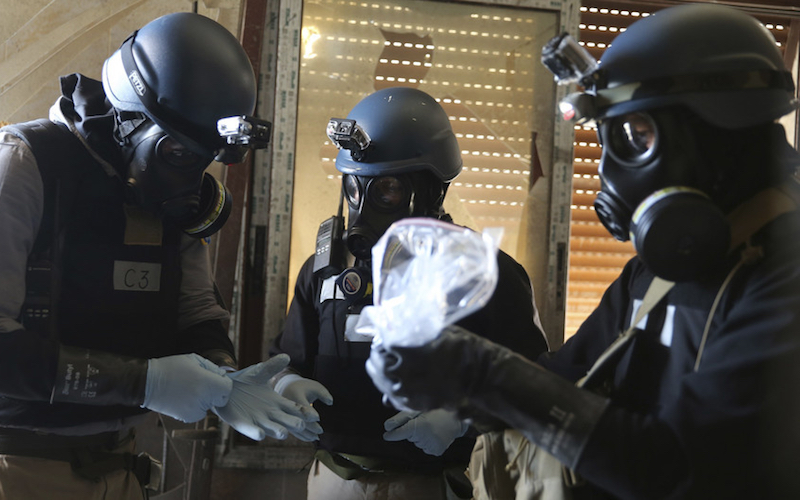
Africa, and the World, Not Ready to Address CBRN
There appears to be consensus that the international community is not yet prepared to address the full scope of chemical, biological, radiological or nuclear (CBRN) threats and risks. At the same time, Africa struggles to counter violent extremist groups, particularly the growth of al-Qaeda in the Islamic Maghreb, Boko Haram in Nigeria, al-Shabaab in Somalia, and ISIL in Libya. Combining the two, can extremists steal and/or produce CBRN materials from Africa like Islamic State has done in Iraq and Syria?
The good news and the bad news
Let’s start with the good news. International and regional organizations with African members continue to adopt applicable international resolutions and laws to combat the issue. For example, the UN Security Council unanimously adopted Resolution 1540 in 2004, declaring the proliferation of CBRN and their means of delivery as a threat that needs dealing with. The Convention on the Physical Protection of Nuclear Materials is another document that came into force in May 2016. It covers the protection of nuclear materials used for peaceful purposes during international transport.
The bad news, or where the problem lies, is implementation. According to Professor Michael Rosenthal, an expert on the UN 1540 Committee which overseas nuclear security globally, African countries are the least compliant in global nuclear security safeguards. They implement only a third of the nuclear weapons safeguards required by the UNSC 1540 Committee. Rosenthal argues this is due to a lack of resources and know-how, making Africa vulnerable to terror groups.
It’s the individual state’s responsibility to implement the amendments. Wealthier countries like Singapore are developing newer technologies to deal with items like detecting CBRN at their ports. Most African countries lack financial resources and are more concerned with the conventional fight against extremism, and therefore need more multilateral and bilateral assistance. Morocco believes that without greater regional and international cooperation, national initiatives dealing with CBRN will fall short. South Africa echoes this, recognizing that states without the resources to carry out their obligations need cooperation, especially in terms of national legislation, and capacity-building, among others.
Risks of CBRN theft, development or attack
The elimination of Libya’s chemical weapons earlier this week is an example of the process working well. Libya’s UN-brokered national unity government in July made a formal request for assistance to remove leftover chemical weapons from the Gaddafi regime. Then UN Security Council Resolution 2298 (2016), adopted on July 22, authorized “Member States to acquire, control, transport, transfer and destroy chemical weapons identified by the Organisation for the Prohibition of Chemical Weapons (OPCW) in Libya to ensure that the country’s stockpile was eliminated in the “soonest and safest” manner.” With the help of the OPCW, the UN and countries like Britain, Canada, Denmark, Finland, France, Germany, Italy, Malta, Spain, Britain and the United States, the last of the hundreds of tons of chemical weapons was removed at the end of August.
This removal was due to the growth of the Islamic State and political instability with fears the stockpile would be taken by militants. Libya’s disarmament process was originally started on December 19, 2003 when Gaddafi renounced his weapons of mass destruction programs. The disposal of chemical weapons was only partially complete when the intervention in 2011 took place.
Libya also had an advanced nuclear program. However, the last of Libya’s HEU left the country on a Russian chartered plane on December 21, 2009. Libya retains a stockpile of natural uranium ore concentrate, also known as yellowcake, which is stored in a former military facility near Sebha in Libya’s south. According to the US State Department, the risk of trafficking and proliferation of this material is low due to “the bulk and weight of the storage containers and the need for extensive additional processing before the material would be suitable for weapons purposes.”
An extremist organization getting their hands on highly enriched uranium (HEU) and the technology to use it is by far the worst case of all CBRN terrorism scenarios. The Islamic State has bragged it can buy a nuclear weapon from Pakistan. This is particularly troubling because of Pakistan’s growing stockpile and proliferation history.
Charles D. Ferguson and William Potter explain that there are four main nuclear terrorism scenarios: 1) The theft and detonation of an intact nuclear weapon from a military nuclear facility. 2) The theft or purchase of fissile material leading to the fabrication and detonation of an improvised nuclear devise (IND). 3) Attacks against and sabotage of nuclear facilities, in particular nuclear power plants, causing the release of large amounts of radioactivity. 4) The unauthorized acquisition of radioactive materials contributing to the fabrication and detonation of a “dirty bomb.”
All of Africa’s nuclear weapons programs have ended including those in Egypt, Libya and South Africa. Today HEU is an extremely rare commodity in Africa. Since Libya’s clean out in 2009, only Ghana, Nigeria, and South Africa continue to possess HEU. Ghana and Nigeria each possess less than 1 kilogram. It’s only the Pelindaba research center, outside of Pretoria, South Africa where you find large quantities of weapons grade material. In 2007, one group penetrated deep into the site to steal it but failed. South Africa’s State Security Agency believes China was behind the break-in in order to steal technology for a new kind of nuclear power.
Other nuclear facilities in Africa do exist. This includes research reactors typically found at universities. Their lower enriched nuclear material can be used to make a dirty radiological bomb. However, of the world’s 243 operational research reactors, only 10 are in Africa. South Africa is the only African country with an operating nuclear power station, but other African countries are exploring the option.
A nuclear or radiological attack delivers the immediate ‘shock’ an extremist group typically opts for, but controls are tight compared to biological and chemical materials. Plus they are much harder to produce.
Intelligence reports have indicated groups such as Al Qaeda in the Maghreb have made multiple attempts to manufacture CBRN materials. According to Iraqi and US intelligence officials, the Islamic State is aggressively pursuing further development of chemical weapons and has set up a branch dedicated to research and experiments using scientists from throughout the Middle East.
Unfortunately there is limited open source information regarding African countries current chemical and biological weapons. This includes possible Egyptian, or Sudanese, but programs are not likely. Accusations were made in early 2016 of the Sudanese Army using chemical weapons on the South Sudanese. The UN Mission in South Sudan (UNMISS) investigated and declared that there were no signs of chemical weapons and that smoke inhaled by children may have come from either conventional weapons or tear gas.
Unlike the immediate awareness and understanding one receives after a chemical attack takes place, a biological attack is like a silent, killer submarine. It takes time to determine exactly what the illness is, where it came from and who is in danger. And before you know it, it may be too late. Think about an infected person in a major African city who often travels often for work.
Reports from 2009 show 40 al-Qaeda linked militants being killed by the plague at a training camp in Algeria with claims they were developing the disease as a weapon.
Bioterrorism is a scary scenario due to its ability to spread, especially given the predicated growth of African air travel. The International Air Transport Association predicts that by 2034, Africa will have a total market of 294 million passengers. In 2015, Africa had 79.5 million passengers, up 1.8% from 2014.
The world was fortunate the Ebola outbreak occurred in more rural areas, which in turn, helped the containment effort.
Progress but not quite there
Progress has been made, like the international cooperation success stories mentioned earlier. Moreover, we are seeing more widely attended bilateral and multilateral workshops taking place in Africa. On April 18-22, 2016 the Center for Nonproliferation Studies and the African Center for Science and International Security conducted their first joint capacity-building workshop on nuclear security in Africa. This included a tour to the Ghana Atomic Energy Commission where participants visited Ghana’s research reactor currently being converted from HEU uranium as fuel to low-enriched uranium.
Regarding bioterrorism, we learned lessons from the Ebola, Yellow Fever and other outbreaks. It’s important to rapidly get ‘boots on the ground.’ Communities have responded with institutions like the African Union Center for Disease Control similar to America’s Center for Disease Control prepared to help do this. The latter has set up its own Global Rapid Response Team to help strengthen the global emergency workforce. However, we will likely need more “healthkeeping” missions similar to the UN Mission for Ebola Emergency Response in the future, but these are not planned.
Again there is a consensus that Africa and the international community are not adequately prepared to prevent or respond to a CBRN attack. There are growing concerns not so much about country stockpiles of CBRN but of dual-use goods. These are materials that can be used for peaceful or deadly purposes. These materials often bring you into the private sector realm with the company having oversight and often there is limited government knowledge.
CBRN is a massive and wide ranging issue that warrants more discussion, funding and implementation of both preventive and reactionary measures. Both the 1540 Comprehensive Review and the Biological Weapons Convention Review Conference are coming up in November. They are opportunities to take these discussions forward, and more importantly, to implement concentrated steps on how instruments can be strengthened

